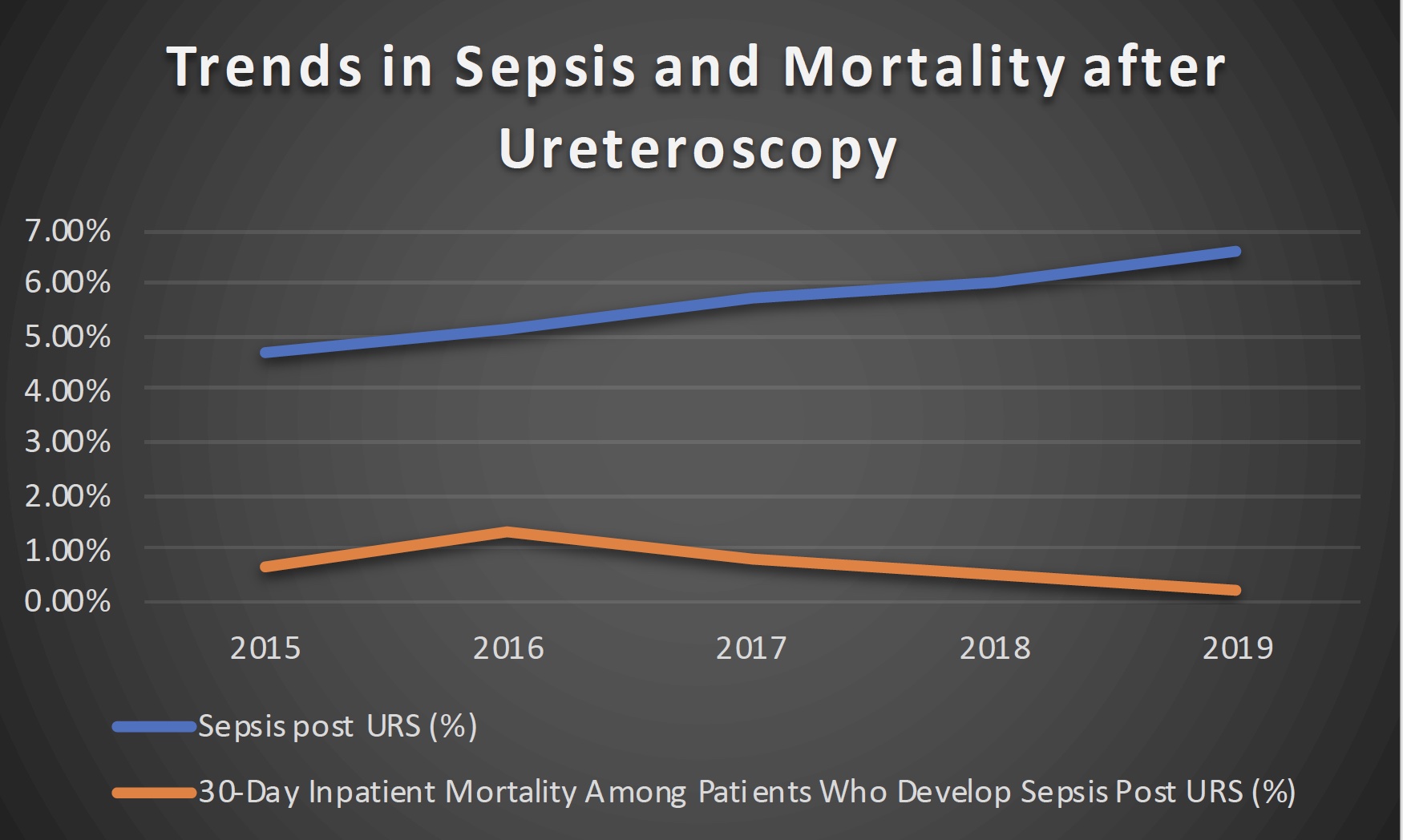Back
Introduction: Post-ureteroscopy sepsis is a morbid condition that requires significant healthcare utilization. We investigated all-cause inpatient mortality, rates of intensive care unit (ICU) and inpatient admissions and readmissions. We also examine the yearly trends in sepsis and inpatient mortality in patients undergoing ureteroscopy (URS) in the United States (US).
Methods: Retrospective analyses were conducted using the IBM MarketScan Database to identify patients =18 years who underwent URS. Three cohorts were analyzed: non-sepsis (control), non-severe sepsis, and severe sepsis (sepsis + organ dysfunction). All-cause inpatient mortality and healthcare utilization including ICU admissions, inpatient admissions and readmissions were reported. Annual trends for sepsis events and inpatient mortality post-URS were examined from 2015-2019.
Results: 109,496 URS patients were identified. 5.6% developed sepsis within 30 days of URS. Of the 5.6%, 4.1% developed non-severe sepsis and 1.5% developed severe sepsis. The 30-day all-cause inpatient mortality for the non-sepsis, non-severe sepsis and severe sepsis cohorts was 0.03%, 0.27% and 2.5%, respectively (p < 0.001). Severe sepsis substantially increased the risk of 30-day all-cause inpatient mortality compared to patients who did not develop sepsis (HR: 49.5; 95% CI: 28.9-84.7; p< 0.001). ICU admission rates were 1.5%, 19.8% 52.4% for the non-sepsis, non-severe sepsis, and severe sepsis cohorts, respectively (p < 0.001). Inpatient admissions were 18.3%, 74.9%, and 76.9% (p < 0.001), while readmissions were 7.1%, 12.0%, and 15.9% (p < 0.001), for the non-sepsis, non-severe sepsis, and severe sepsis cohorts, respectively. From 2015 to 2019, the annual prevalence of sepsis post URS increased significantly yearly from 4.7%, 5.1%, 5.7%, 6.0%, to 6.6% (p < 0.001), however the rate of inpatient mortality remained stable (Figure 1).
Conclusions: Sepsis post-URS significantly increases the risk of 30-day all cause inpatient mortality and leads to a significant increase in hospital admissions, ICU admissions, and readmissions. Over the 5-year study period, the prevalence of sepsis post-URS increased by 40%. Urologists should be aware of the increasing prevalence of this potentially deadly post-operative complication. SOURCE OF
Funding: Boston Scientific

Podium Session
Session: PD34: Stone Disease: Epidemiology & Evaluation II
PD34-10: Impact of Sepsis on Admissions, Re Admissions and Mortality Following Ureteroscopy
Sunday, April 30, 2023
2:30 PM – 2:40 PM CST
Location: S502

Naeem Bhojani, MD, FRCSC
Associate Professor
University of Montreal
Podium Presenter(s)
Introduction: Post-ureteroscopy sepsis is a morbid condition that requires significant healthcare utilization. We investigated all-cause inpatient mortality, rates of intensive care unit (ICU) and inpatient admissions and readmissions. We also examine the yearly trends in sepsis and inpatient mortality in patients undergoing ureteroscopy (URS) in the United States (US).
Methods: Retrospective analyses were conducted using the IBM MarketScan Database to identify patients =18 years who underwent URS. Three cohorts were analyzed: non-sepsis (control), non-severe sepsis, and severe sepsis (sepsis + organ dysfunction). All-cause inpatient mortality and healthcare utilization including ICU admissions, inpatient admissions and readmissions were reported. Annual trends for sepsis events and inpatient mortality post-URS were examined from 2015-2019.
Results: 109,496 URS patients were identified. 5.6% developed sepsis within 30 days of URS. Of the 5.6%, 4.1% developed non-severe sepsis and 1.5% developed severe sepsis. The 30-day all-cause inpatient mortality for the non-sepsis, non-severe sepsis and severe sepsis cohorts was 0.03%, 0.27% and 2.5%, respectively (p < 0.001). Severe sepsis substantially increased the risk of 30-day all-cause inpatient mortality compared to patients who did not develop sepsis (HR: 49.5; 95% CI: 28.9-84.7; p< 0.001). ICU admission rates were 1.5%, 19.8% 52.4% for the non-sepsis, non-severe sepsis, and severe sepsis cohorts, respectively (p < 0.001). Inpatient admissions were 18.3%, 74.9%, and 76.9% (p < 0.001), while readmissions were 7.1%, 12.0%, and 15.9% (p < 0.001), for the non-sepsis, non-severe sepsis, and severe sepsis cohorts, respectively. From 2015 to 2019, the annual prevalence of sepsis post URS increased significantly yearly from 4.7%, 5.1%, 5.7%, 6.0%, to 6.6% (p < 0.001), however the rate of inpatient mortality remained stable (Figure 1).
Conclusions: Sepsis post-URS significantly increases the risk of 30-day all cause inpatient mortality and leads to a significant increase in hospital admissions, ICU admissions, and readmissions. Over the 5-year study period, the prevalence of sepsis post-URS increased by 40%. Urologists should be aware of the increasing prevalence of this potentially deadly post-operative complication. SOURCE OF
Funding: Boston Scientific

